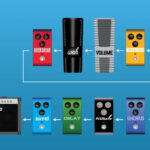One channel that consistently offers insightful gear reviews is Studio Life on YouTube, particularly their series “Is It Shit“. Based in the UK, they rigorously evaluate plugins and studio hardware, providing honest opinions on usability, effectiveness, quality, and value. Their reviewers possess genuine expertise in engineering and production, setting them apart from many channels. This expertise is why when the opportunity arose to review the Line 6 Guitar Pod Express, I was immediately interested. Thanks to Andrew at Cosmo Music for making this review possible.
Line 6, a key brand within Yamaha Music, is renowned for its professional-grade Helix, HX Effects, and HX Stomp units. For those with some years in the guitar world, the original POD is likely a familiar name – a pioneering desktop unit packed with diverse effects and amp simulations. While opinions on the original POD were divided, its popularity and widespread adoption were undeniable.
The POD Express represents Line 6’s current entry-level offering in the POD series for both guitar and bass. Positioned as a more affordable option than the POD GO, it comes with a street price of around $269 CAD MAP. For this review, I received the POD Express for Guitar.
Upon unboxing, my first impression wasn’t entirely positive. The plastic casing of the POD Express evoked memories of a certain underwhelming yellow and blue plastic multi-effects unit from the mid-90s. Line 6 officially describes the material as polycarbonate. However, in hand, it feels like basic plastic, similar in robustness to a cheap toy from a children’s party venue. Durability concerns were immediate.
Despite the initial impression, the POD Express packs a significant punch in its small red enclosure. It boasts seven amp simulations, seven cabinet simulations, seventeen individual effects, and a looper. This is a substantial feature set for such a budget-friendly device.
Powering the unit is flexible, accepting either 3 AA batteries or an external power supply (not included). Plugging a guitar cable into the input jack brings the unit online, and the left footswitch acts as a master activation for the entire system. While individual sections like amp sim, delay, reverb, modulation, or distortion can be toggled on or off via their respective knobs, there’s no dedicated footswitch control for these sections without adding external footswitches. Even then, with only two footswitch ports available, external control remains limited to a maximum of two parameters.
For outputs, the POD Express offers dual ¼” jacks suitable for connecting to a PA system, FRFR speakers, or a traditional guitar amplifier. When using a guitar amp, it’s crucial to disable the amp and cabinet simulations within the POD Express to avoid unwanted layering of amp and cabinet models – unless, of course, that’s the desired effect. A ⅛” headphone jack is also included for silent practice. The overall output level is managed by a small rotary dial located on the side, reminiscent of volume controls on older transistor radios.
The on/off and tap tempo/tuner footswitches seem reasonably functional. However, the plastic housing raises concerns about long-term durability, particularly under the pressure of regular stomping during performance. There’s a lingering worry that a forceful stomp could potentially damage the switch or even crack the plastic casing.


